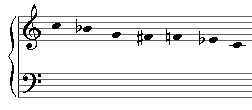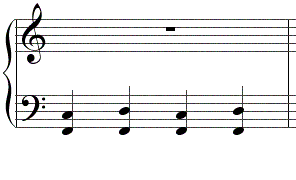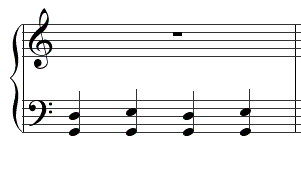Piano Lesson: Beginner Blues for Piano Part 4
by David Bruce
In the final lesson in this series we're going to build a 12 bar blues progression and, using the blues scale in
the right hand, improvise over the top. Once you've cracked it, its no exaggeration to say that these simple ingredients
can provide you with a lifetime of pleasure!
Following on from the improvisation we did in Part
3, the next step is to use the whole of the blues scale (learned in
Part
3, the next step is to use the whole of the blues scale (learned in  Part
2) in the right hand in our improvisation.
Part
2) in the right hand in our improvisation.
It might sound something like this (all the improvisation here uses the notes shown in the top staff):
Now it's time to forget the right hand for the moment and look at what's going on in the bass.
To create our 12 bar blues progression we are going to need two more left hand positions. One on F:
and up a tone to G:
Now it's time to put it all together.
The basic twelve bar blues follows a 12 bar chord progression as follows:
C - C - C - C - F - F - C - C - G - F - C - C
1 - 2 - 3 - 4 - 5 - 6 - 7 - 8 - 9 - 10- 11- 12
You remember the first left hand rhythm we learned, using a CG - CF pair in the left hand? Well TWO such pairs correspond to the a bar - or to ONE letter C shown above. Similarly, 2 pairs on the F chords correspond to a letter F, and the same for G.
So here's how the overall left hand pattern will look.

The final step - have you guessed yet - is to improvise using the full blues scale whilst playing this progression.
The hardest thing about this you may find is remembering to change the left hand pattern at the right point. There's no easy secret to this, other than that old chestnut - practice!
Play the progression over and over again until it's really in your blood before even trying to add the right hand.
You could also start by just playing one or two notes in the right hand before adding other notes later.
Here's an example of an entire 12 bar improvisation:
 Blues Playalong Jam Tracks, professional quality tracks you can jam along to.
Blues Playalong Jam Tracks, professional quality tracks you can jam along to.
We also have a collection of Improvisation Pieces, sheet music with sections for improvising.
Improvisation Pieces, sheet music with sections for improvising.
Following on from the improvisation we did in
It might sound something like this (all the improvisation here uses the notes shown in the top staff):
Now it's time to forget the right hand for the moment and look at what's going on in the bass.
To create our 12 bar blues progression we are going to need two more left hand positions. One on F:
and up a tone to G:
The 12 bar blues progression
Now it's time to put it all together.
The basic twelve bar blues follows a 12 bar chord progression as follows:
C - C - C - C - F - F - C - C - G - F - C - C
1 - 2 - 3 - 4 - 5 - 6 - 7 - 8 - 9 - 10- 11- 12
You remember the first left hand rhythm we learned, using a CG - CF pair in the left hand? Well TWO such pairs correspond to the a bar - or to ONE letter C shown above. Similarly, 2 pairs on the F chords correspond to a letter F, and the same for G.
So here's how the overall left hand pattern will look.

The final step - have you guessed yet - is to improvise using the full blues scale whilst playing this progression.
The hardest thing about this you may find is remembering to change the left hand pattern at the right point. There's no easy secret to this, other than that old chestnut - practice!
Play the progression over and over again until it's really in your blood before even trying to add the right hand.
You could also start by just playing one or two notes in the right hand before adding other notes later.
Here's an example of an entire 12 bar improvisation:
Where to go from here.
- Once you're comfortable with the right hand, try moving beyond the octave up the keys - using the same scale of course. This adds a massive range of colour to the improvisation and should make your blues really start to sound professional
- Look into variations on the blues pattern. Using a G instead of the last C is a good way to build into the start of the next 12bar
- Always try to keep a sense of phrasing - questions and answers.
- Don't be afraid to leave large gaps in the melody, while the left hand chugs on - this can be very effective.
We also have a collection of




